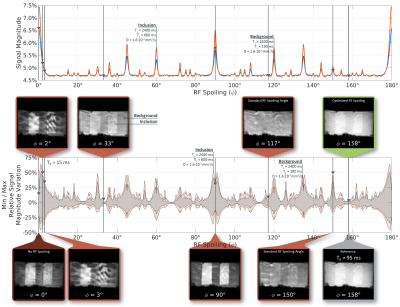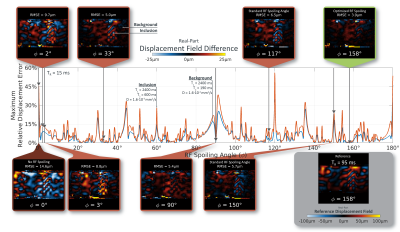3307
Optimal RF-Spoiling for Bias-Free Displacement Field Estimation in Fast 3D MR Elastography Sequences1University and ETH Zurich, Zurich, Switzerland
Synopsis
RF-spoiling is employed in order to reduce transverse coherences. While spoiling angles are typically optimized for contrast, efficacy for bias-free phase-contrast measurements is yet to be proven. Here, we investigate the influence of the RF-spoiling angle on displacement estimates in fast GRE-MR Elastography sequences using Extended Phase Graph simulations. Theoretical findings are validated using a novel RF-spoiling test sequence as well as conventional MRE phantom experiments. An optimal spoiling angle of 158° degrees is identified allowing for bias-free MRE acquisitions at repetition times as low as 5ms.
Introduction
MR Elastography (MRE) utilizes phase-contrast MR imaging to determine the local shear displacement field resulting from external actuation.1 As customary in gradient-echo (GRE) phase-contrast MRI, RF-spoiling with a quadratic phase increment$$\;\phi_n=\phi_{n-1}+n\cdot\phi\;$$is employed to reduce transverse coherences and thus the influence of spin-history on the overall MR signal.2–5 RF-spoiling angles have been optimized to produce contrast in agreement to Ernst’s simplified GRE-contrast equation and to produce bias-free$$$\;$$$T1 and$$$\;$$$B1$$$\;$$$estimates.2,6–8 As magnetization in MRE is subject only to minute periodic displacement and hence resides in the imaging volume for the whole scan, spin-history effects can interfere with encoding especially when short repetition times are employed. While current MRE acquisition schemes, relying on multi-slice schemes with long per-slice repetition time, are less prone to spin-history artifacts, accelerated acquisitions using e.g. compressed sensing with undersampling along two phase-encode directions necessitate switching to slab excitation and very short TR. Here, the efficacy of RF-spoiling remains to be investigated.In the present work, extended phase graph (EPG) simulations are used to study the influence of RF spoiling angles on the phase-contrast signal in 3D GRE-MRE. A test sequence is proposed allowing to directly quantify the effect of spin history on the encoded displacement. The theoretical findings are validated using phantom experiments.9,10 An optimal spoiling angle of$$$\;\phi=158^\circ\;$$$is identified showing minimal displacement errors.
Methods
An EPG simulation of an RF-spoiled GRE sequence was extended to include periodic phase accrual as found in fast GRE-MRE sequences such as Ristretto or eXpresso MRE (Figure 1A) by adding a phase to the configuration states$$$\;F_k\;$$$in each$$$\;$$$TR11,12$$F_k\;\to\;F_k\;e^{i\angle_n}.$$Phase encoding from spoiling gradients was neglected as phase-difference measurements were simulated. The simulation was iterated to steady state to allow the extraction of both signal magnitude and phase enabling the comparison between reconstructed and input displacement (EPG Parameters in Figure 3).An RF-spoiling test sequence was designed replacing the MEG in the Ristretto MRE sequence by a unipolar gradient in readout direction. Sinusoidal stepping of the gradient (Figure 1B) results in equivalent periodic phase accrual as in conventional MRE without the need of actuation. As shown in Figure 1C, the apparent displacement is directly given by the product of the voxel position in readout direction$$$\;x\;$$$and the maximum encoding moment$$$\;k_0\;$$$allowing to exactly quantify the displacement error over a wide range of input displacements.
Ristretto GRE-MRE measurements with Hadamard encoding were performed on a 3T Ingenia system (Philips, Best, The Netherlands) on a QA phantom (CIRS, Norfolk, USA) using electromagnetic actuation (Sequence parameters in Figure 4).11,13
The test sequence was employed on the same scanner in an agarose phantom. A maximum encoding moment of$$\;k_0=142.5\;\text{rad/m}\;$$was used creating an apparent displacement of ±1.5π over$$$\;\sim$$$70mm. Images were processed as in MRE using 2D unwrapping (SNAPHU),14 temporal unwrapping, directional decoding,13 followed by Fourier transformation (Figure 3A).
Both sequences were repeated with different RF spoiling angles, i.e.$$$\;\phi=0^\circ\;$$$(no RF spoiling), 117° and 150° (vendor depending defaults) as well as 158° (proposed optimal spoiling angle). Flip angles were chosen as the Ernst angle with$$$\;$$$T1=750ms$$$\;$$$(Liver at 3T).
Results & Discussion
Figure 2 shows the EPG simulation results as a function of RF spoiling angle$$$\;\phi\;$$$and$$$\;$$$TR. (A) depicts the magnitude variation as a result of transverse coherences. In (B), the upper limit on input vs. reconstructed displacement is shown, where maximal deviations of 34% are identified, when no RF spoiling is employed. Conventional spoiling angles of$$$\;\phi=117^\circ\;$$$and$$$\;\phi=150^\circ\;$$$reduce displacement errors down to 14%. An optimal spoiling angle of$$$\;\phi=158^\circ\;$$$can be identified minimizing both displacement error and magnitude variations. For the four marked spoiling angles, (C) denotes relative displacement error as a function of the input displacement and$$$\;$$$TR, where (D) shows the dependence on$$$\;$$$T1 and$$$\;$$$T2.In Figure 3C, the absolute error between reconstructed and input displacement is shown for both the test sequence and theoretical predictions. Theory and experiment are in good agreement. Minimal displacement errors are found in the case of$$$\;\phi=158^\circ$$$.
In Figure 4, predicted magnitude variations are compared with MRE phantom experiments for TR=15ms. Pronounced spin-history dependent magnitude variations can be observed for spoiling angles of 0°, 2°, 3°, 90° and 150°.$$$\;$$$117°$$$\;$$$shows reduced artifacts especially in the background gel, whereas artifacts are visible in the right inclusion due to its longer$$$\;$$$T2$$$\;$$$relaxation time. For$$$\;\phi=158^\circ$$$, no magnitude variation can be observed and overall contrast compares well with the reference image (bottom right).
Figure 5 depicts the displacement field difference to the reference scan (bottom right,$$$\;$$$TR=95ms). Low spoiling angles as well as disabled RF-spoiling show pronounced displacement error, which is spatially varying depending on relaxation properties. Estimates are improved using the standard RF spoiling angles of 117° and 150°, however, minimal error was again found in the case of$$$\;\phi=158^\circ$$$.
Conclusion
The use of RF-spoiling in GRE-MRE, especially when employing short repetition times (e.g. in 3D scans), is necessary to reduce biases in displacement estimates. While default spoiling angles are helping in reducing transverse coherences, an optimal spoiling angle of$$$\;\phi=158^\circ\;$$$could be identified for Ristretto MRE with four wave phase offsets, allowing bias-free displacement field estimation at repetition times as low as 5ms. Due to the strong dependence on the exact phase accrual, further analysis is warranted regarding different number of wave phase offsets and Ristretto phase interleave orderings before 158° can be established as a general optimized spoiling angle.Acknowledgements
This project has received funding from the European Union’s Horizon 2020 research and innovation programme under grant agreement No 668039.References
1. Muthupillai R, Lomas D, Rossman P, Greenleaf J, Manduca A, Ehman R. Magnetic resonance elastography by direct visualization of propagating acoustic strain waves. Science (80- ). 1995;269(5232):1854-1857. doi:10.1126/science.7569924
2. Zur Y, Wood ML, Neuringer LJ. Spoiling of transverse magnetization in steady-state sequences. Magn Reson Med. 1991;21(2):251-263. doi:10.1002/mrm.1910210210
3. Crawley AP, Wood ML, Henkelman RM. Elimination of transverse coherences in FLASH MRI. Magn Reson Med. 1988;8(3):248-260. doi:10.1002/mrm.1910080303
4. Duyn JH. Steady state effects in fast gradient echo magnetic resonance imaging. Magn Reson Med. 1997;37(4):559-568. doi:10.1002/mrm.1910370414
5. Markl M, Frydrychowicz A, Kozerke S, Hope M, Wieben O. 4D flow MRI. J Magn Reson Imaging. 2012;36(5):1015-1036. doi:10.1002/jmri.23632
6. Treier R, Steingoetter A, Fried M, Schwizer W, Boesiger P. Optimized and Combined T 1 and B 1 Mapping Technique for Fast and Accurate T 1 Quantification in Contrast- Enhanced Abdominal MRI. 2007;576:568-576. doi:10.1002/mrm.21177
7. Preibisch C, Deichmann R. Influence of RF Spoiling on the Stability and Accuracy of T 1 Mapping Based on Spoiled FLASH With Varying Flip Angles. 2009;135:125-135. doi:10.1002/mrm.21776
8. Yarnykh VL. Actual flip-angle imaging in the pulsed steady state: A method for rapid three-dimensional mapping of the transmitted radiofrequency field. Magn Reson Med. 2007;57(1):192-200. doi:10.1002/mrm.21120
9. Weigel M. Extended phase graphs: Dephasing, RF pulses, and echoes - pure and simple. J Magn Reson Imaging. 2015;41(2):266-295. doi:10.1002/jmri.24619
10. Guenthner C, Kozerke S. Unipolar MR Elastography: Theory, Numerical Analysis and Implementation. NMR Biomed. 2019. doi:10.1002/nbm.4138
11. Guenthner C, Sethi S, Troelstra M, Dokumaci AS, Sinkus R, Kozerke S. Ristretto MRE: A generalized multi‐shot GRE‐MRE sequence. NMR Biomed. 2019;32(5):e4049. doi:10.1002/nbm.4049
12. Garteiser P, Sahebjavaher RS, Ter Beek LC, et al. Rapid acquisition of multifrequency, multislice and multidirectional MR elastography data with a fractionally encoded gradient echo sequence. NMR Biomed. 2013;26(10):1326-1335. doi:10.1002/nbm.2958
13. Guenthner C, Runge JH, Sinkus R, Kozerke S. Analysis and improvement of motion encoding in magnetic resonance elastography. NMR Biomed. 2018;31(5):e3908. doi:10.1002/nbm.3908
14. Chen CW, Zebker HA. Phase unwrapping for large SAR interferograms: statistical segmentation and generalized network models. IEEE Trans Geosci Remote Sens. 2002;40(8):1709-1719. doi:10.1109/TGRS.2002.802453
Figures
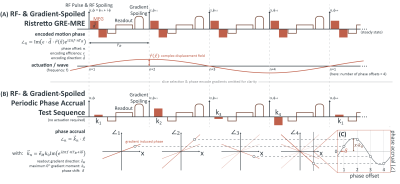
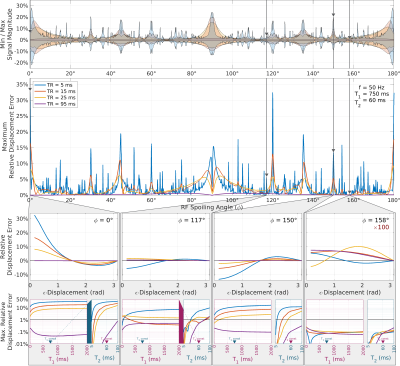
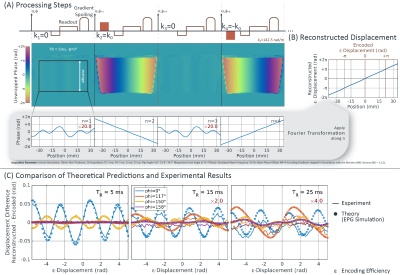
Figure 3: (A) pictorial description of the processing steps for the test sequence data showing the unwrapped phase images for each of the four simulated wave-phase offsets. While n=1 & 3 should show no phase accrual (encoding gradient off), phase fluctuations can be observed resulting from spin-history effects.
(B) shows the difference between encoded and reconstructed displacement for three different TR and four spoiling angles comparing theory (circles) with experimental results (lines). Minimal displacement error is found for Φ=158° as predicted in the EPG simualtions.
